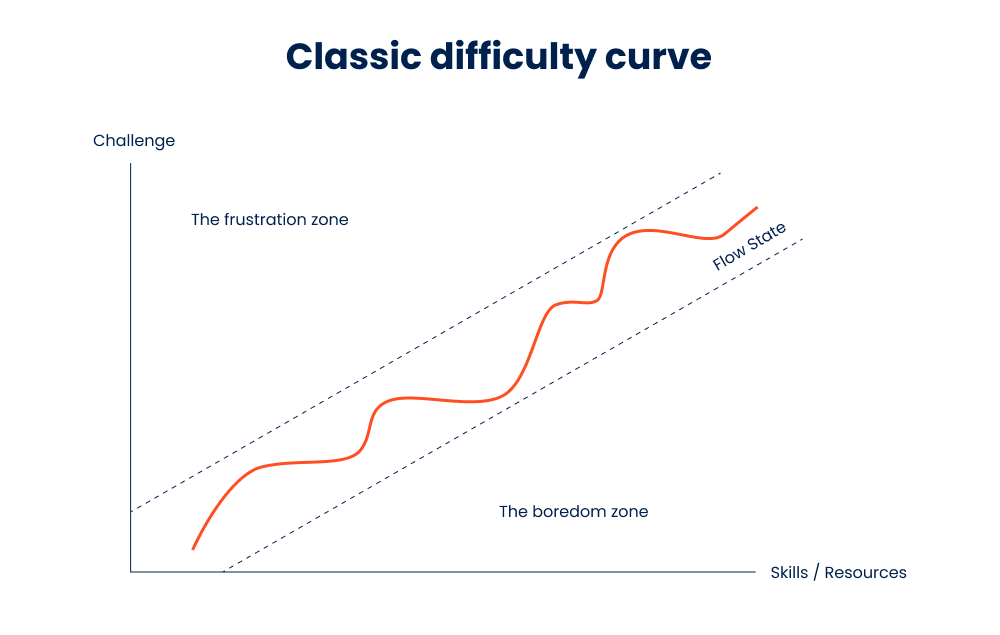Your difficulty curve has a major role to play in preventing players from churning in your games.
A well-implemented difficulty curve is all about striking the right balance between players’ skill and your game’s challenge level. Get it right, and you can stop players from getting bored, motivate them to watch rewarded videos or make in-app purchases (IAP), and push them to keep progressing.
Why are difficulty curves important for your games?
Players play games for one reason - to have fun. So, your job as a game developer is to give your players the best in-app experience possible, but fun is a tough thing to solve for. It’s much easier to start with what’s not fun: boredom and frustration.
And nothing is more frustrating than a game that’s too difficult and keeps players from progressing. On the other hand, if a game is too easy, then the lack of challenge will bore players. Both situations will have the same result - players churning.
The level of difficulty can have a big impact on your game’s revenue. If your game isn’t challenging enough, your players won’t be as motivated to earn rewards from rewarded videos or make IAPs. But if your game is too difficult, players might feel like your rewarded videos or IAPs are a waste of their money and time. Again, both situations have the same result - a failure to motivate, retain, and monetize players.
So what does a well-implemented difficulty curve look like?
The optimal difficulty curve puts your players into a ‘flow state,’ where the difficulty level is slightly above the player’s skill at first, but not so tough as to feel insurmountable. Without the initial challenge, the player won’t get the satisfaction of progressing past it, but the challenge should remain within the player’s reach to avoid frustration.

We can map out this flow state by using “challenge” as the Y axis and “skills/resources” as the X axis. Where X exceeds Y we enter the boredom zone. Where Y exceeds X we enter the frustration zone. The flow state is where the player is neither in the boredom nor frustration zone. To keep players in the flow state, make sure to match the game’s difficulty level to the skill level players have as they progress. It’s important to note that while the principles may be the same, there is no one-size-fits-all difficulty curve for every genre.
How to spot when your difficulty curve isn’t working
Two core metrics will help you identify problematic points in your difficulty curve - the retention and completion rates. With retention, you can identify the levels that have your players churning, while the completion rate will help you to see where users are completing levels too quickly.
If you see that your retention rate dips after a specific level in the game, the difficulty level at that point is likely too high. Conversely, if completion rates are consistently very high at a specific level, particularly at a late-stage level, your game is likely too easy.
Keep in mind that several factors can influence players churning or completing levels too quickly besides difficulty level: crashing and invasive ads are two common causes of churn - best practice is to always ensure there are no other influences on retention before looking to difficulty as a culprit.
Balancing your difficulty curve
Getting players into the flow state and adapting your difficulty curve is a balancing act, particularly since a game’s difficulty needs to be examined case by case. But, there are a few general tips to help you to strike the right balance, regardless of your game’s genre.
First, to add difficulty to your game, you can either reduce the availability of resources or add complexity. You can reduce resources by raising the costs of in-game actions, making costs more frequent, or giving players fewer ways to gather resources. To increase complexity, you can add more enemies, give players multiple problems to solve at the same time, or shorten the time they have to take an action - all are essentially ways to test more of the player’s skill.
Conversely, you can lessen the difficulty of a game by either reducing its complexity or making more resources available to them. This is where resources from rewarded videos and IAPs come in. To motivate the player to watch a rewarded video and gain resources, you can use the difficulty inflection point, the point where a game’s challenge exceeds the player’s skill or resources. Alternatively, you can motivate them to make a purchase to accomplish the same goal.
Let’s take a look at how Tall Man Run balanced its difficulty curve.
Difficulty balancing in action: Tall Man Run
Tall Man Run is a gate runner game where the goal is to run through size-multiplier gates while avoiding obstacles to become large enough to defeat a boss enemy at the end of the level. Good gates grow your character, while bad gates shrink them. For gate runner games like Tall Man Run, the difficulty curve’s incline is generally lower, meaning the increase in difficulty is incremental. Developers typically increase difficulty for this genre by shortening the distance between the gates and adding new obstacles, so players have less time to react.
In Tall Man Run, when difficulty eventually exceeds the skill level of the player, it’s offset by the introduction of power-ups. These can include things like a dash power-up to skip past tough obstacles or a shield that doubles the benefits from good gates. As the difficulty increases, the power-ups will become more necessary, motivating players to engage with rewarded videos or make IAPs.
If a level is identified as too difficult in the game, this difficulty can be reduced by either decreasing the skill needed (making the distance between good gates and bad gates or obstacles longer) or by giving the players power-ups. If, on the other hand, players are completing the game/levels too quickly and aren’t watching RVs or making IAPs, the distance between obstacles and gates can be shortened, obstacles can be added, or the availability of free power-ups can be reduced to rebalance the difficulty.
Make your difficulty curve work for you, easily
Balancing your difficulty curve can seem like a huge task, as it requires setting your retention and completion rate benchmarks, checking your analytics, detecting imbalances, and then fixing them. But the pay-offs make it worthwhile - your difficulty will either work against your game’s success or will be one of the best resources you have to motivate and monetize users. Get it right, and you’re a big step closer to turning your game into a profitable hit.
Luckily for you, Supersonic has tools for that. Supersonic’s level analytics tool allows you to detect changes in player behavior across your levels and includes metrics like start, completion, continuation, and fail rates, allowing you to visually pinpoint the specific levels players are churning. Used together with Supersonic’s Crash Center, you can easily and quickly identify why players are churning and where.
Let's put these tips to good use
Publish your game with Supersonic



